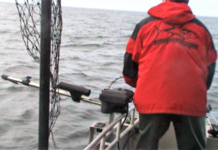
A CTD Rosette is lowered into the water to measure the salinity, temperature, depth and concentration of particles in the water column. Image courtesy of NOAA Okeanos Explorer Program, INDEX-SATAL 2010.
A CTD device’s primary function is to detect how the conductivity and temperature of the water column changes relative to depth. Conductivity is a measure of how well a solution conducts electricity. Conductivity is directly related to salinity, which is the concentration of salt and other inorganic compounds in seawater. Salinity is one of the most basic measurements used by ocean scientists. When combined with temperature data, salinity measurements can be used to determine seawater density which is a primary driving force for major ocean currents.
Often, CTDs are attached to a much larger metal frame called a rosette, which may hold water-sampling bottles that are used to collect water at different depths, as well as other sensors that can measure additional physical or chemical properties.
CTDs can provide profiles of chemical and physical parameters through the entire water column. By analyzing these parameters, scientists can make inferences about the occurrence of certain biological processes, such as the growth of algae. Sudden changes, or “anomalies,” in one or more of the properties being measured may alert scientists to an unusual occurrence, such as an active hydrothermal vent.
Knowledge obtained from CTD devices can, in turn, lead scientists to a better understanding of such factors as species distribution and abundance in particular areas of the ocean.
For More Information:
How to Use CTD Data (pdf, 867 kb), Gulf of Mexico 2012 Okeanos Explorer Expedition
Sign up for the Ocean Explorer E-mail Update List.














